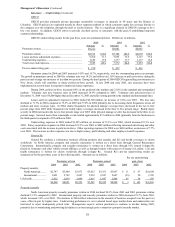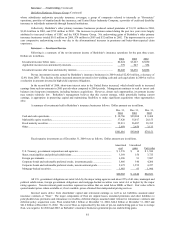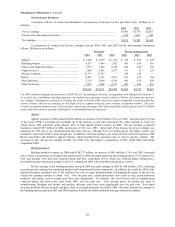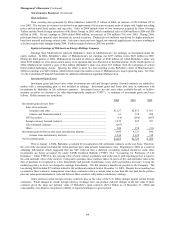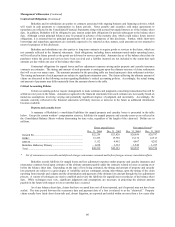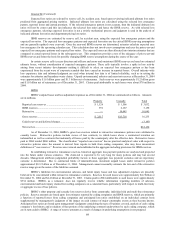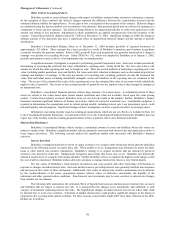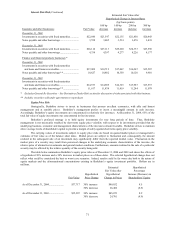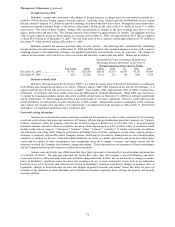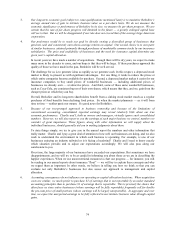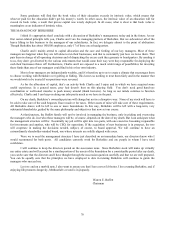Berkshire Hathaway 2004 Annual Report Download - page 69
Download and view the complete annual report
Please find page 69 of the 2004 Berkshire Hathaway annual report below. You can navigate through the pages in the report by either clicking on the pages listed below, or by using the keyword search tool below to find specific information within the annual report.
68
Management’s Discussion (Continued)
Property and casualty losses (Continued)
GEICO (Continued)
For each of its major coverages, GEICO tests the adequacy of the total loss reserves using one or more actuarial
projections based on claim closure models, paid loss triangles and incurred loss triangles. Each type of projection analyzes loss
occurrence data for claims occurring in a given period over intervals of time until substantially all of the expected claims have
been settled.
GEICO’ s exposure to highly uncertain losses is believed to be limited to certain commercial excess umbrella policies
written during a period from 1981 to 1984. Remaining reserves associated with such exposure is currently a relatively
insignificant component of GEICO’ s total reserves (3%) and there is little if any apparent asbestos or environmental liability
exposure. Related claim activity over the past year was insignificant.
General Re
General Re’ s unpaid losses and loss adjustment expenses as of December 31, 2004 are summarized below. Amounts
are in millions.
Workers’
Property Compensation Casualty Total
Reported case reserves ............................... $ 1,996 $ 2,168 $ 8,204 $12,368
IBNR reserves ............................................ 1,361 957 7,572 9,890
Gross reserves ............................................ $ 3,357 $ 3,125 $15,776 22,258
Ceded reserves and deferred charges.......... (2,202)
Net reserves................................................ $20,056
General Re’ s process of establishing loss reserve estimates is based upon a ground-up approach, beginning with case
estimates and supplemented by additional case reserves (“ACR’ s”) and IBNR reserves. Critical judgments in the establishment
of these loss reserves involve the establishment of ACR’ s by claim examiners, the expectation of ultimate loss ratios, which
drive IBNR reserve amounts and the case reserve reporting trends compared to the expected loss reporting patterns. Actuaries do
not routinely calculate loss reserve ranges, because it is currently believed that the mathematics of determining ranges has not
been sufficiently developed and the myriad of assumptions required, render such resulting range to be unreliable. In addition,
counts of claims or average amount per claim are not utilized because clients do not consistently provide reliable data in
sufficient detail.
General Re claim examiners establish case reserve estimates based on the facts and circumstances of the claims and the
terms and provisions of the insurance and reinsurance contracts. For reinsurance claims, claim examiners receive notices from
client companies in a manner that reflects the terms of the reinsurance contracts. Contract terms governing claim reporting are
generally based on the client’ s view of the case loss (e.g., claims with reserves greater than one-half the retention) or injury type
(e.g., any claim arising from a fatality). Some reinsurance contracts permit claims to be reported on a bulk basis. Bulk reporting
provisions generally apply to quota-share reinsurance contracts.
Upon notification of a reinsurance claim from a ceding company, claim examiners make independent evaluations of
loss amounts. In some cases, examiners’ estimates differ from amounts reported by ceding companies. If the examiners’
estimates are significantly greater than the ceding company’ s estimates, the claims are further investigated. If deemed
appropriate, ACR’ s are established above the amount reported by the ceding company. Examiners also conduct claim reviews at
client companies periodically and case reserves are often increased as a result. In 2004, claim examiners conducted in excess of
400 claim reviews.
Actuaries classify all loss and premium data into segments (reserve cells) primarily based on product (e.g., treaty,
facultative, and program) and line of business (e.g., auto liability, property, etc.). For each reserve cell, losses are aggregated by
accident year and analyzed over time. Depending on client reporting practices, some losses and premiums are aggregated by
policy year. These loss aggregations are called loss triangles, which are the primary basis for IBNR reserve calculations. North
American operations presently review over 300 reserve cells and the international operations presently review about 900 reserve
cells.
Loss triangles are used to determine the expected case loss emergence patterns and, in conjunction with expected loss
ratios by accident year, are further used to determine IBNR reserves. Certain calculations are performed and form the basis for
estimating the expected loss emergence pattern. The determination of the expected loss emergence pattern is not strictly a
mechanical process. In instances where the historical loss data is insufficient, estimation formulas are used along with reliance
on other loss triangles and judgment. Factors affecting loss development triangles include but are not limited to the following:
changing client claims practices, changes in claim examiners use of ACR’ s or the frequency of client company claim reviews,
changes in the mix of policy terms and coverage (such as client loss retention levels and occurrence and aggregate policy limits),
changes in loss trends and changes in legal trends that result in unanticipated losses, as well as other sources of statistical
variability. These items influence the selection of the expected loss emergence patterns.


